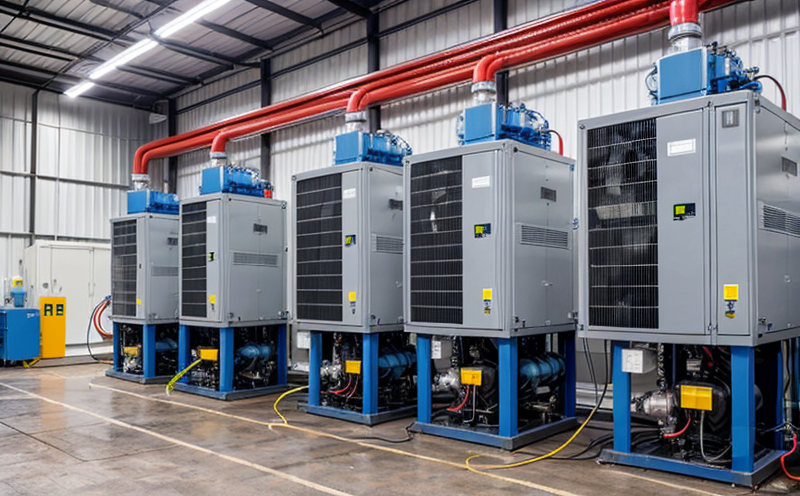Power factor correction system inspection
The power factor is a measure of how effectively electrical energy is being used in an AC circuit. A low power factor can result in wasted electricity, increased losses, and higher costs for the end user. Power factor correction (PFC) systems are designed to improve this efficiency by compensating for reactive power, which helps balance the system's active and reactive loads.
Our inspection service focuses on evaluating the performance of PFC systems installed across various industries. This ensures that these critical components meet regulatory requirements and operational standards. The inspection process includes a detailed review of both the hardware and software aspects of the PFC system, ensuring they are functioning optimally within their intended environment.
Our team uses advanced instrumentation to measure key parameters such as current, voltage, power factor angle, and reactive power consumption. These measurements are compared against established standards like IEEE 1546-2018 for industrial applications or IEC 61334-2-27 for distribution systems. Compliance with these standards is essential to ensure reliable operation of the PFC system.
During our inspections, we also check for any signs of wear and tear that could indicate potential failure points in the future. Regular maintenance checks can help prevent costly downtime and reduce the risk of unexpected disruptions during critical operations.
The importance of maintaining proper power factor cannot be overstated, especially considering today’s emphasis on sustainable practices. By improving the efficiency of electrical systems through effective PFC implementation, organizations not only save money but also contribute positively to environmental conservation efforts.
Our service goes beyond just checking compliance; it offers a comprehensive understanding of how well your current setup is performing and identifies areas for improvement. This includes recommendations on necessary adjustments or upgrades that could further enhance the overall performance of your power factor correction system.
| Industry | Description |
|---|---|
| Manufacturing | Ensures efficient operation of motors and transformers, reducing energy costs significantly. |
| Utilities | Improves grid stability by balancing active and reactive power flows more effectively. |
| Data Centers | Minimizes losses in high-density environments where every watt counts towards operational efficiency. |
| Commercial Buildings | Lowers electricity bills while enhancing sustainability credentials through reduced carbon footprint. |
In summary, our power factor correction system inspection service provides detailed evaluations tailored to meet the specific needs of different sectors. It ensures that your PFC systems are not only compliant but also operate at peak efficiency, contributing towards both cost savings and environmental responsibility.
Benefits
The benefits of maintaining a well-inspected power factor correction system extend far beyond just meeting regulatory requirements. Here are some key advantages:
- Cost Savings: By reducing losses due to poor efficiency, organizations can significantly cut their energy bills.
- Better System Performance: Properly functioning PFC systems enhance the overall performance of electrical equipment, leading to extended lifespan and better reliability.
- Environmental Impact: With improved power factor correction comes reduced greenhouse gas emissions, contributing positively towards sustainability goals.
- Regulatory Compliance: Ensuring compliance with relevant standards helps avoid penalties associated with non-compliance.
- Increased Efficiency: Enhanced efficiency translates directly into increased productivity and competitiveness within the industry.
These benefits underscore why regular inspections of PFC systems are crucial for any organization looking to optimize its energy usage while staying ahead in terms of operational excellence.
Industry Applications
| Industry | Description |
|---|---|
| Manufacturing | PFC systems in manufacturing plants help manage large motors and transformers efficiently, thereby minimizing energy consumption. |
| Utilities | In utility grids, PFC improves voltage regulation by balancing active and reactive power flows, enhancing grid stability. |
| Data Centers | Data centers are optimized for high-density computing environments where every watt saved contributes to operational efficiency. |
| Commercial Buildings | Buildings benefit from lower electricity costs through reduced energy usage, contributing positively towards environmental sustainability. |
The diverse applications across these sectors highlight the versatility and importance of having a robust PFC system inspection service. Whether it's for industrial manufacturing processes or commercial building operations, our inspections ensure that all systems are operating at their best possible levels.
Why Choose This Test?
Selecting a reliable and experienced provider for your power factor correction system inspection is crucial. Here’s why you should choose us:
- Expertise: Our team comprises highly skilled professionals who have extensive experience in electrical engineering and testing.
- State-of-the-Art Equipment: We utilize cutting-edge instrumentation capable of providing precise measurements and accurate assessments.
- Comprehensive Reporting: Every inspection comes with detailed reports that outline findings, recommendations for improvements, and compliance status.
- Customer Focus: Our services are designed to meet the unique needs of our clients, ensuring they receive solutions tailored specifically for their requirements.
- Timely Delivery: We understand the importance of scheduling inspections at convenient times without disrupting regular operations.
- Dedicated Support: Post-inspection support is available for any questions or concerns you may have regarding our findings and recommendations.
We pride ourselves on delivering high-quality, reliable services that contribute to long-term success for our clients. By choosing us, you’re investing in the future sustainability and efficiency of your power factor correction systems.





